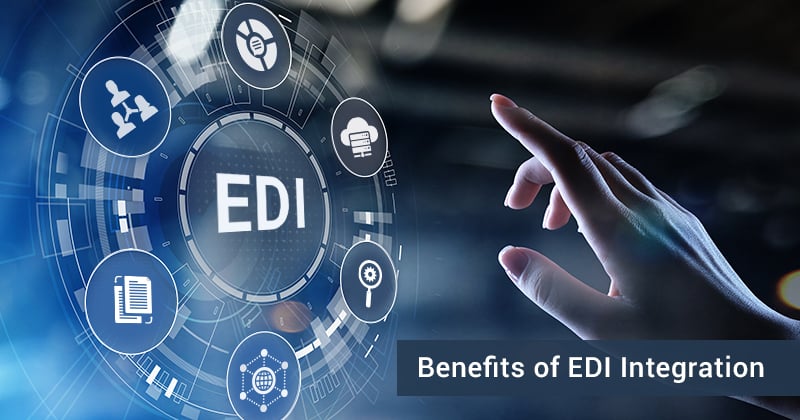Electronic Data Interchange (EDI) Integration: 10 Key Benefits
 Jerry Caous
Jerry Caous
Table of contents
Has migrating to an efficient, easy-to-maintain, scalable, and secure software — one that seamlessly integrates complex supply chain functions into your ERP — been on your wish list recently?
If you answered ‘yes’, you’re not alone. According to a 2017 Elsevier study, many organizations spend a significant chunk of their IT budgets maintaining outdated and costly legacy systems or processes (think paper documents, manual data entry, daily emails), which negatively impact their ROIs. It becomes imperative, therefore, to seriously consider migrating to a more technologically advanced and eco-friendly solution to improve the operational efficiency of your business — lest you find yourself stuck in a process rut.
As a business integration expert here at STAEDEAN, I believe integrating an EDI solution into your company’s ERP can help you here. EDI or Electronic Data Interchange is the exchange of business information in a standard, computer-readable format. It allows trading partners to transmit purchase orders, shipping notices, invoices, receipts, and acknowledgments among each other faster and makes document interchange easier. It improves your company’s customer connection, stabilizes your supply chain operations, and enables greater transparency in your partner and customer communications. (Now that’s one thing off your wish list!)
In this blog, I will cover ten massive benefits your business can expect out of an EDI integration. But first, let me briefly explain what an EDI integration is.
Defining EDI Integration
An EDI integration involves setting up an automated supply chain workflow with well-defined standards and protocols on your company’s ERP (such as Microsoft Dynamics 365), so as to enable your ERP to transfer and receive electronic documents in a recognized data format.
An EDI software is responsible for exchanging information between businesses in a standard and secure format, with the help of an EDI translator. Integrating this software with your ERP helps you communicate with your trading partners efficiently, thus optimizing your supply chain workflow. In comparison to a stand-alone EDI solution, an EDI integration automates data workflows and streamlines the supply chain process from one end to the other.
Let’s now go over the various benefits of an EDI integration in detail.
Benefits of an EDI Integration
1. Enhanced business efficiency
Integrating an EDI solution into your ERP allows you to automate your business transactions and replace paper-based tasks with an electronic counterpart, thereby reducing the turnover time drastically. This also results in increased business productivity, as your team is now left with more time to concentrate on revenue-building strategies rather than on mundane purchase order activities.
2. Reduced operational costs
One of the biggest benefits of an EDI integration is that it works out to be only a third of the cost you would incur if your processes were paper-based. For most businesses, this would include the printing, filing, posting, or retrieving of physical documents such as invoices or notices. An automated EDI solution also relieves the burden of manual data entry off your team’s shoulders, resulting in increased productivity — and correspondingly, higher revenue.
3. Improved processing speed
With an EDI integration, you would be able to automate business processes throughout your supply chain by entering preset rules that automatically trigger the exchange of data. This ensures that business-critical information is transmitted, received, and processed on time, thus improving speed as well as operational efficiency.
4. Enriched performance
Despite its technical limitations, system complexity, lack of scalability, and high maintenance costs, organizations continue to prefer using obsolete legacy systems and processes due to the fear that they might not be able to successfully run and maintain a new software. No doubt, the cost of a new system might also seem high to them. However, when weighed against the year-on-year expenses incurred in maintaining age-old legacy systems, an EDI implementation is not only a more profitable option but is also less complex, more secure, more long-lasting, and scalable. Moreover, an EDI integration is centralized and better suited for today’s fast-paced business processes, giving you a superior performance over outdated systems.
5. Improved data security
Adopting an EDI solution allows you to transfer data among trading partners in line with pre-defined and customized security protocols, through a securely established connection. Therefore, it becomes easier for you to maintain the confidentiality and integrity of sensitive business documents, thus improving your organization’s security assurance.
6. Seamless data interchange
One of the major benefits you could expect out of an EDI integration is to be able to receive or transmit electronic data seamlessly and without disruption. An EDI solution allows you to create a smooth communication channel among all the stakeholders, ensuring that reliable and accurate data is updated and distributed in real time.
7. Enhanced scalability
An EDI integration helps you keep up with the times by making your operations more scalable and adaptable to changing business and technical requirements. It helps you make continuous improvements to your business model, thereby fostering your company’s business relationships with its partners and customers.
8. Enhanced B2B success
Since many B2B companies today already have an EDI system in place to expedite their supply chain process, an EDI software would likely be an indispensable solution for your organization — especially if it falls into the B2B sector. An EDI integration also makes partnering with newer companies easier, as it now becomes convenient for both parties to send out transactional documents electronically (also referred to as EDI messages in technical parlance) to each other.
9. Reduced carbon footprint
Your company’s CSR goal of going paperless can surely be achieved with an EDI integration that facilitates the electronic transfer of business documents and company information across ERP systems. Not only can you easily go green but you can also discard the use of error-prone paper documents, give up writing cumbersome emails, and reduce physical data entries, helping you keep up with the ethos of modern business.
10. Greater competitive advantage
With an EDI integration, your business need not be restricted to a specific geographical location, as an EDI software allows you to transact with partners and customers globally. An EDI solution standardizes your business language, improving the visibility and responsiveness of your supply chain process while reducing the delivery turnaround time — with minimal human intervention — affording you a competitive advantage over other businesses.
In a world where connectivity is taken for granted and IT managers struggle with integrating different systems, applications, or processes, organizations that do not take the necessary measures to connect better and faster will find themselves losing clients. Taking a decisive step towards EDI integration can help you solve connectivity problems and improve your value chain. It makes the interchange of data more convenient and secure, expedites transactions, minimizes paper trails, and reduces delivery times — which, in the long run, results in improved stakeholder relationships and successful B2B projects!
Leverage the Benefits of EDI Integration with EDI Studio for Dynamics 365 F&SCM
To help you maximize your business efficiency and leverage the benefits of EDI integration, STAEDEAN offers you our no-code EDI Studio for Microsoft Dynamics 365 Finance and Supply Chain Management (D365 F&SCM) that can help you simplify your partner communication and improve customer collaboration through seamless electronic data interchange. With EDI Studio, D365 F&SCM customers can benefit from an embedded EDI solution that allows D365 users to onboard trading partners and go live with EDI in less than 30 days!
However, we understand that you may have many questions that you would like answered before committing to an EDI software. To help you in your decision-making process, we recommend that you download our Buyer's Guide to EDI Software Selection in D365 F&SCM from the link shared below which will give you tips on selecting the right EDI solution based on your unique requirements.

